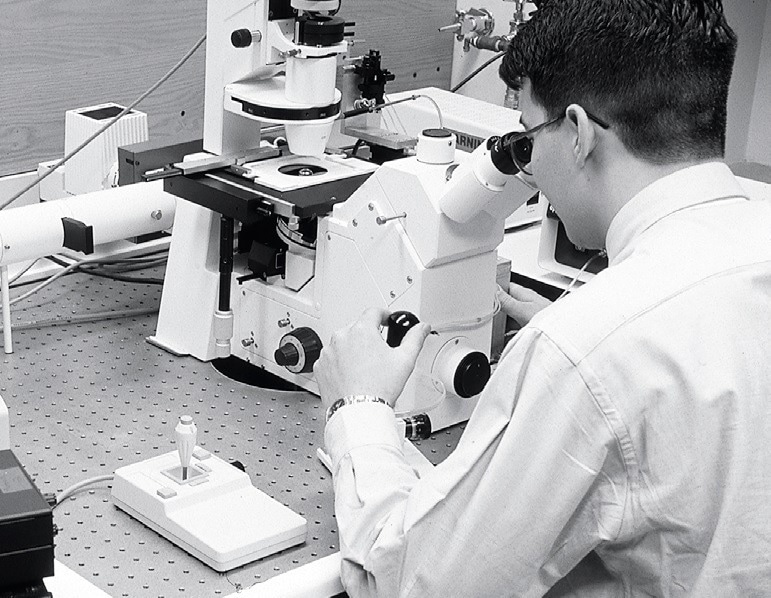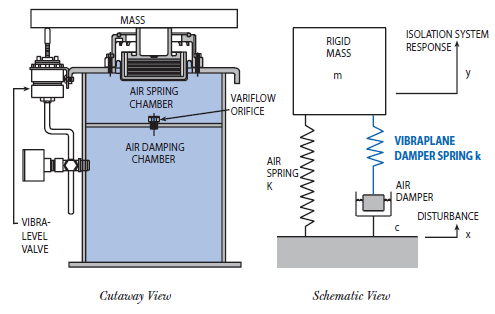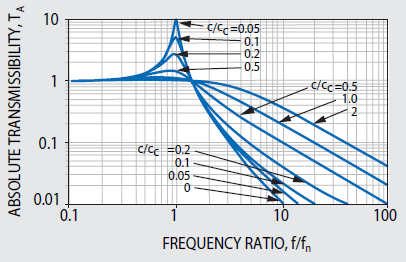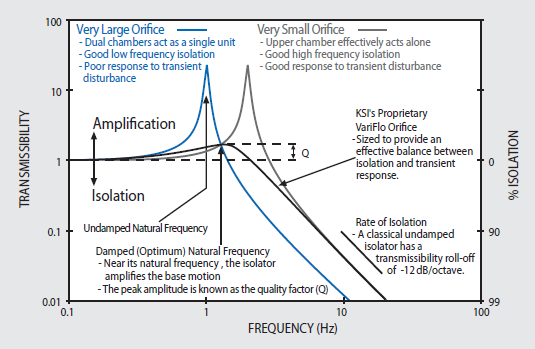Traditional isolators are built with metal springs or rubber blocks. They have low internal damping and generally are only effective at frequencies near 10 Hz. They also offer little to no isolation at frequencies higher than 30 Hz due to “harmonic standing waves” that occur at sonic velocities in the rubber or metal.

Image Credit: Kinetic Systems, Inc.
Figure 43.1 shows the Vibraplane design concept. This design removes metal springs and rubber blocks. Instead, a frictionless rolling diaphragm air seal supports a load-carrying piston in collaboration with dual air chambers functioning as the spring and damping medium. The stiffness of the air spring is a result of the combined air volume of the dual chambers. This conveniently offers the very low stiffness needed to obtain very low natural frequency, which is required for high-efficiency isolation. “Harmonic standing waves” cannot occur in the Vibraplane System because of this dual air chamber internal damping design.

Figure 43.1. VIBRAPLANE Airmou. Image Credit: Kinetic Systems, Inc.
Vibraplane Systems are Mobile
Contemporary and future building vibration requirements are unspecified, making isolating vibration in individual pieces of sensitive equipment at the point of installation the safest and most cost-effective vibration control method in high-technology facilities.
Vibraplane high-performance systems offer vibration control independent of building construction for both OEM and end-user installations. Unlike concrete inertia blocks or fixed support piers, vibraplane isolation systems are relatively compact and mobile.
The Vibraplane system can be easily changed or moved in the future. Alternatively, modifying buildings and internal structures is costly and permanent with little or no allowance for future needs.
Kinetic Systems Inc.’s vibration surveys demonstrate that building vibrations are typically complex and can be characterized using a broadband random vibration spectrum with several superimposed strong discrete “tonal” frequencies.
The broadband random vibration spectrum ranges from 8 to 200 Hz. The discrete tonal frequencies commonly occur between 8 to 80 Hz and are due to motors, blowers, generators, pulleys, and gears, etc.
Most observed vibrations are vertical, with horizontal vibrations accounting for 25% to 30% of the vertical on average. The frequency spectrum is invariant. However, discrete frequency amplitudes range by several orders of magnitude in accordance with the location and distance from the source of the disturbance.
In any location, the generalizations above establish an 8 to 200 Hz frequency spectrum of concern for choosing vibration control to limit damaging environmental frequencies that can coincide with the natural frequencies of equipment. KSI’s standard Vibraplane vibration isolation systems are designed with a low 1 to 2 Hz natural frequency that will attenuate all potentially damaging vibration amplitudes in the 8 to 200 Hz environment spectrum.
Better Damping
The Vibraplane uses a proprietary Variflo™ orifice design to control the flow between air chambers, improving damping control at both high and low amplitudes and frequencies. This design guarantees an even air flow at all amplitudes with no risk of choking, which maintains the effectiveness of both (airspring) chamber volumes.
Figure 43.1 offers the schematic representation of Variflo damping incorporating a “filtering” spring. This compares against the conventional isolator model of Figure 42.1, where the damper is directly coupled to the mass, resulting in a loss of isolation at high frequencies, as shown in Figure 42.2.

Figure 42.1. Typical Isolator Represented as a Mass, Spring and Dashpot. Image Credit: Kinetic Systems, Inc.

Figure 42.2. Influence of Damping in Vibration Isolation. Image Credit: Kinetic Systems, Inc.
The Variflo damping (air) spring decouples the damper at high frequencies, meaning no isolation is lost, whereas in a conventional isolator, high damping forces would typically reduce efficiency.
Zero Friction
The Vibraplane design utilizes a thin-walled, frictionless, rolling diaphragm to assist the (airspring) piston. This prevents friction locking, a key cause of isolation loss for low-frequency, micro-inch disturbances in traditional isolators.
Vibraplane Transmissibility
Vibraplane’s dual chamber design uniquely optimizes its vibration transmissibility performance (see Figure 45.1). At low frequencies, the air volume in both air chambers is effective, leading to a large air volume and a soft, low natural frequency system. This is seen in the “left” arm of the transmissibility curve.

Figure 45.1. VIBRAPLANE Transmissibility. Image Credit: Kinetic Systems, Inc.
At high frequencies, the orifice gradually restricts the airflow, resulting in only the small chamber being effective and the system stiffening, represented by the “right” arm of the transmissibility curve.
The proprietary orifice design of KSI is amplitude sensitive and configured to create the “optimum” transmissibility bound by the left and right arms. Vibraplane allows the ideal conditions seen in maximum damping at resonance and minimum damping at high frequencies, resulting in improved isolation than possible with traditional isolation systems.
Active-Air Leveling
Vibraplane Active-Air leveling offers leveling compensation and a large load range. Using a compressed air source and KSI’s proprietary Vibralevel Air Servo Valves, the air is added into or teased from the air springs to adhere to a preset “zero deflection” level and compensate for changes in the load.
Horizontal Vibration Control
In buildings, horizontal vibrations account for 25% to 30% of the vertical and are typically less critical. Even with that, the Vibraplane System also offers the Kinematic Horizontal Isolation Piston to offer isolation for any vibration environment without regard of direction.
Rubber-in-shear elements built into the piston simultaneously translate and rock in a low-frequency paired response action to horizontal inputs. KSI BaseMate Platforms utilize an omnidirectional low-frequency pendulum system to remove horizontal vibrations.
Early in development, KSI saw that precise system leveling is crucial for proper horizontal vibration isolation and was the first to provide mechanical leveling feet on all workstations. This ensured the maximum efficiency of the zero friction design. The leveling feet equalize the piston extension and prevent rubbing friction caused by frame tilt.
Structural Damping
Kinetic Systems structural damping eliminates “ringing” resulting from resonances in table, frame, and platform structures external to the Vibraplane air spring suspension system.
There is resonance in all structures, no matter how large or stiff. Damping augmentation is the most efficient way to eliminate vibration energy.
KSI’s engineering staff continues to conduct research and development into new and improved damping technologies and incorporates these into all Vibraplane systems.
KSI uses viscoelastic damping laminations and “tuned absorbers” on composite, solid, and honeycomb platforms and tables. Frame structures are bolted through viscoelastic laminations.

This information has been sourced, reviewed and adapted from materials provided by Kinetic Systems, Inc.
For more information on this source, please visit Kinetic Systems, Inc.